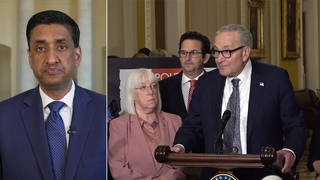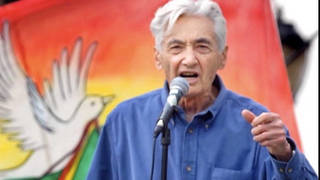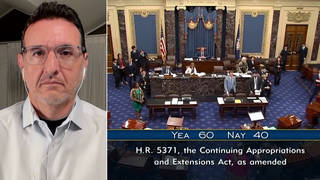
Guests
- Barbara Collinsworked more than eight years at Wal-Mart in Placerville, California. As one of the Organization United for Respect at Walmart’s (OUR Walmart) top leaders, she led her co-workers out on strike last Black Friday, as well as other strikes. She was later fired for her organizing efforts. She joins us from Bentonville, Arkansas, where Wal-Mart’s headquarters is located. She’s been protesting there since Friday.
- Catherine Ruetschlinpolicy analyst at Demos, where she co-authored the new report, “A Higher Wage is Possible: How Walmart Can Invest in Its Workforce Without Costing Customers a Dime.”
As Black Friday approaches, Wal-Mart workers and activists are planning another round of protests and strikes at the nation’s largest employer on the biggest shopping day of the year. The Black Friday protests come at a time of heightened scrutiny for the company. It made headlines last week when a photo surfaced online of a sign made by workers at one of its stores in Ohio. The sign was taped to a table and read: “Please Donate Food Items Here, so Associates in Need Can Enjoy Thanksgiving Dinner.” Wal-Mart says the food drive shows the company tries to help its workers. But critics say it reveals the low wages Wal-Mart pays them. The National Labor Relations Board also ruled last week that Wal-Mart violated the rights of striking workers. We are joined by Catherine Ruetschlin, a policy analyst at Demos who co-authored the new report, “A Higher Wage is Possible: How Walmart Can Invest in Its Workforce Without Costing Customers a Dime.” We also speak with Barbara Collins, a former Wal-Mart employee fired after last year’s Black Friday strike. Collins speaks to us from Bentonville, Arkansas, where Wal-Mart’s headquarters is located. She has been protesting there since Friday as part of a group of eight fired workers who are demanding their jobs back after the NLRB’s ruling that their firing was unfair.
Transcript
NERMEEN SHAIKH: As the busiest shopping season of the year gets underway, we look at what could be the biggest day of action yet against the retail giant Wal-Mart. The Black Friday protests come at a time of turmoil for the company. On Monday, the company announced its CEO, Mike Duke, was retiring and would be replaced by Doug McMillon, who started out as a teenage worker in a Wal-Mart warehouse. Last week, the company, which is the largest private employer in the United States and the world, made headlines when a photo surfaced online of a sign made by workers at one of its stores in Ohio. The sign was taped to a table and read, quote, “Please donate food Items here so Associates in Need can enjoy Thanksgiving Dinner.”
AMY GOODMAN: Wal-Mart says the food drive shows the company tries to help its workers. But critics say it reveals the low wages Wal-Mart pays them. Now the food drive photo is being featured in a TV ad by the campaign OUR Walmart, short for the Organization United for Respect at Walmart. It calls on workers to go on strike and join more than 1,500 protests scheduled on Black Friday.
WAL-MART AD: There’s more to Wal-Mart than you think.
CNN ANCHOR: “Please donate food items here so associates in need can enjoy Thanksgiving dinner”?
WEWS REPORTER: Employees are donating food, not to the community, but to co-workers in need.
TODAY SHOW CLIP: They are one of the most successful companies—I mean, money-wise, what they bring in and the family that owns it.
CHRIS HAYES: Doing a food drive for their own employees was something they didn’t have to do in the first place.
MARTHA SELLERS: All of your sales floor associates and cashiers are struggling to make a living.
WAL-MART AD: That’s the real Wal-Mart.
NERMEEN SHAIKH: This comes as the National Labor Relations Board ruled last week that Wal-Mart violated the rights of striking workers. In a statement, the NLRB said Wal-Mart, quote, “unlawfully threatened, disciplined, and/or terminated employees for having engaged in legally protected strikes and protests.” The incidents include last year’s Black Friday protest that saw workers lead rallies at more than a thousand Wal-Mart stores and another strike at stores across the country this past June. The NLRB says it will pursue charges unless Wal-Mart can reach an agreement with the workers in the coming weeks. Wal-Mart spokesperson Jerry Lundberg says the company will, quote, “pursue our options to defend the company because we believe our actions were legal and justified.”
AMY GOODMAN: For more, we’re joined by former Wal-Mart worker Barbara Collins, who was employed for eight years at a store in Placerville, California. A year ago on Black Friday, she joined OUR Walmart and led her co-workers out on strike. She was later fired for her organizing efforts. She’s joining us from Bentonville, Arkansas, where Wal-Mart’s headquarters is located. She’s been protesting there since Friday as part of a group of eight fired workers who are demanding their jobs back after the NLRB’s ruling that their firing was unfair.
We’re joined here in New York by Catherine Ruetschlin, a policy analyst at Demos. She co-authored their new report, “A Higher Wage is Possible: How Walmart Can Invest in Its Workforce Without Costing Customers a Dime.” Last year she wrote the related report, “Retail’s Hidden Potential: How Raising Wages Would Benefit Workers, the Industry and the Overall Economy.”
We welcome you both to Democracy Now! Let’s first go to Barbara in Bentonville, Arkansas. Talk about the NLRB ruling and what exactly happened to you last year.
BARBARA COLLINS: Yes, hi, everyone. I was—I just need to clarify something. I was actually terminated in June. So I participated on the Black Friday strike last year, and then I also participated with the two-week-long strike in June. And in June is when I was terminated for speaking out.
But the NLRB—excuse me—the NLRB ruling is just overwhelming. We are really excited that they found that we’re telling the truth, that they broke the law. And we want to be reinstated. So we are here in Bentonville, and it’s very cold. And we’ve been out in front of home office every day, Friday, Saturday and then yesterday, and we’ll be out there today.
AMY GOODMAN: Protesting.
BARBARA COLLINS: Yes, asking them to respect the law and to reinstate us.
AMY GOODMAN: Catherine Ruetschlin, talk about what OUR Walmart, the organizing that’s going on all over the country, has now put out in this ad this appeal by Wal-Mart to its employees to help other employees who maybe don’t have enough money for food on Thanksgiving. Talk about the significance of this.
CATHERINE RUETSCHLIN: Sure. You know, the revelation of that food drive in Canton, Ohio, is a really important moment for people outside of the retail sector looking in to really see what it means for these workers to stand up to one of the most powerful companies in the world and ask to be treated with dignity and respect. It’s not just at the holidays that workers are struggling. You know, when you earn a poverty-level wage, putting food on the table is always a tough, tough task. We found talking to Wal-Mart workers over and over again that their wages give them just enough to meet their basic needs, and at the end of every month they’re making critical trade-off decisions, you know, determining whether they’re going to get medicine or pay their school fees or put food on the table or keep their electricity on. And so, what workers like Barbara, who are out there, really had a chance to show the average American who interacts with retail all the time and maybe has seen that these protests have been increasing in their intensity, but hasn’t really been able to relate to what that actually means.
NERMEEN SHAIKH But you’ve also pointed out that Wal-Mart is aware that they pay about 825,000 workers more or less poverty wages. So how is this justified? Have you spoken to people at Wal-Mart and gotten a sense of how they can justify this?
CATHERINE RUETSCHLIN: It’s true. Wal-Mart’s CEO—Wal-Mart U.S. CEO Bill Simon, back in September, in a presentation to Goldman Sachs, was actually responding to the workers’ demands and calling out—as they called out Wal-Mart for a fair wage, and saying, “Hey look, we have 425,000 workers who earn the wage that you’re asking for.” But Wal-Mart is the largest employer—the largest private employer in the U.S. That leaves 825,000 low-wage employees. Now, that’s a workforce of temporary workers, part-time workers, workers who wish they could get full-time hours but can’t get them at Wal-Mart. And the business model that Wal-Mart chooses to operate is really this low-road kind of devaluation of their labor force, where they see their workers as easily replaceable and disposable, as opposed to an alternative high-road model where they can invest in that labor force and see greater productivity, sales and a really committed staff.
NERMEEN SHAIKH Well, you’ve said also that Wal-Mart could very easily raise its wages without raising prices. First of all, how is that possible? And second of all, are there other companies, comparable companies in the U.S., that have done that?
CATHERINE RUETSCHLIN: It’s true. Wal-Mart earned $17 billion in profits last year. Now, how they choose to allocate those profits is a business choice. What Wal-Mart did with a pretty substantial portion of it last year was go into the stock market and repurchase their own shares. What that did was consolidate ownership. It gave the Walton family heirs a greater than 50 percent stake in the company for the first time. And it bumps up earnings per share. But that’s kind of a short-term Wall Street maneuver that over time doesn’t actually represent a productive investment in the firm. And a lot of analysts say that as the effects of that kind of one-time buyback wear off, the firm doesn’t actually see any real long-term benefit. If they instead took the $7.6 billion that they used to buy back their own shares and used it to invest in their workforce, they could actually give a raise amounting to almost $6 an hour for all 825,000 of those low-wage workers.
AMY GOODMAN: Amidst criticism of its workers’ low wages, Wal-Mart has been touting its campaign to promote more than 25,000 of its roughly 1.3 million U.S. employees by the end of January. The workers are featured in clips on the company’s YouTube channel, like this one.
GREGORY PORRAS: Hi. How are you doing? My name is Gregory Porras. I’m the produce manager here at Wal-Mart. I started with the company four months ago. I’ve been promoted to department manager three weeks after I started. This time of the year is a really busy time of the year due to Thanksgiving and Christmas. We have a lot of customers that are in the store, so we try to meet all their needs and getting them everything that they want, to make sure that they can take care of their family, too.
AMY GOODMAN: Wal-Mart spokesperson Kory Lundberg says the company already has hundreds of thousands of associates who earn at least $25,000 per year. Catherine Ruetschlin, your response?
CATHERINE RUETSCHLIN: Well, you know, Wal-Mart, by their own admission, is just making the same promotions that they would have made anyway. This isn’t an improvement in their labor standards at all. In fact, what it is, is a lot of workers who have been part-time before and just kind of waiting on the fringes for the opportunity to put in more hours are being kind of touted with a grand fanfare that this is a great promotion. But it doesn’t change the fundamental labor practices at Wal-Mart, where they operate on a model of low investment in their workforce and high turnover. In fact, approximately 500,000 Wal-Mart workers quit every year.
NERMEEN SHAIKH: Barbara Collins, could you say specifically how much you were earning at Wal-Mart? And what message do you have for Wal-Mart’s new CEO, Doug McMillon?
BARBARA COLLINS: Before I was terminated, I was making $12.05 an hour, and I was classified as a full-time associate, but that didn’t mean that I always got 40 hours a week. There was times that I was only scheduled eight hours for a week, 16 hours for a week. So, it would be just a—so, workers, just because they’re classified as full-time, they need to give the full-time hours and act responsible and start respecting the workers. And with the new CEO, I really hope he listens to OUR Walmart. And we’re only asking for a better Wal-Mart and to be—to have them act responsible when they come into the communities and follow through with their promises.
NERMEEN SHAIKH: And, Barbara Collins, you made $12.05 after having worked at Wal-Mart for how long? And did you have any other benefits, like healthcare?
BARBARA COLLINS: I was there for almost eight years, and I had to make the decision to drop my healthcare for me and my children because of my scheduling. No matter what, they were going to take out $36 every paycheck for healthcare. And with it being eight hours a week or 16, maybe 32, I still had to have to pay rent, electricity, put food on the table for me and my two children. So, it was a really hard decision, and I had to cancel it.
AMY GOODMAN: Catherine Ruetschlin, if you could talk about that, the issue of healthcare? And also, you have the owners of Wal-Mart very much involved in the political process, actively campaigning against business regulation, as well as being very much in the sort of the camp of the sort of anti-government approach and support for people, and yet they depend on welfare and government support for their workers.
BARBARA COLLINS: That’s right. A recent report showed that every single Wal-Mart in the country costs taxpayers between $900,000 and one-and-a-half million dollars in support for poverty alleviation programs like critical healthcare for workers and their families. Now, the Waltons see this as a huge subsidy to their company, but they could be making a better business decision. They are part of this organizing against government intervention in the workplace, but they could take upon themselves, in the absence of government action, to pay more wages, and they would see huge gains. They would see greater productivity. They would see lower costs from turnover and training, as workers stick around and are more loyal to the firm. And over the last couple of quarters, Wal-Mart has actually been complaining about unimpressive sales. And they blame this on a challenging retail environment. But what they don’t realize is that they’re generating that challenging retail environment by not putting enough money in the pockets of the people who shop there.
AMY GOODMAN: We want to thank you both for being with us. Catherine Ruetschlin, we will link to your report, “A Higher Wage is Possible: How Walmart Can Invest in Its [Workforce] Without Costing Customers a Dime.” Catherine Ruetschlin is a policy analyst with Demos. And we want to thank Barbara Collins, who worked more than eight years at Wal-Mart in California as one of the Organization United for Respect at Walmart’s top leaders—that’s OUR Walmart. She led her co-workers out on the strike last Black Friday, as well as other strikes, later fired for her organizing. She’s joining us from Bentonville, Arkansas, where Wal-Mart’s headquarters is located. She’s been protesting there since Friday as part of a group of eight fired workers who are calling to get their jobs back after the National Labor Relations Board ruled last week their firing was unfair.
This is Democracy Now! When we come back, another approach to dealing with corporate power. We’ll be joined by the Reverend Billy. We’ll find out why he is facing, oh, about a year in prison. Stay with us.












Media Options